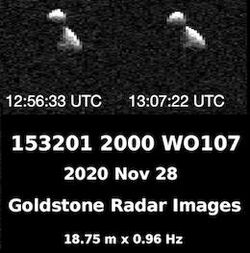Astronomy:(153201) 2000 WO107
 | |
| Discovery[1] | |
|---|---|
| Discovered by | LINEAR |
| Discovery site | Lincoln Lab's ETS |
| Discovery date | 29 November 2000 |
| Designations | |
| (153201) 2000 WO107 | |
| 2000 WO107 | |
| Minor planet category | Aten · NEO · PHA[1][2] |
| Orbital characteristics[1] | |
| Epoch 2020-May-31 (JD 2459000.5) | |
| Uncertainty parameter 0 | |
| Observation arc | 20.0 yr (7,304 days) |
| |{{{apsis}}}|helion}} | 1.6231 AU |
| |{{{apsis}}}|helion}} | 0.2000 AU |
| 0.9115 AU | |
| Eccentricity | 0.7807 |
| Orbital period | 0.87 yr (318 days) |
| Mean anomaly | 206.45° |
| Mean motion | 1° 7m 57.72s / day |
| Inclination | 7.7703° |
| Longitude of ascending node | 69.252° |
| |{{{apsis}}}|helion}} | 13 October 2020 |
| 213.72° | |
| Earth MOID | 0.0031 astronomical unit|AU (460 thousand km; 1.2 LD) |
| Physical characteristics | |
| Mean diameter | 0.510±0.083 km[3] |
| Rotation period | 4.8 hours[4] |
| Geometric albedo | 0.129±0.058[3] |
| SMASS = X[1] | |
| Absolute magnitude (H) | 19.3[1] |
(153201) 2000 WO107 is a sub-kilometer asteroid, classified as near-Earth object and potentially hazardous asteroid of the Aten group with a very well determined orbit.[1] It was discovered on 29 November 2000, by astronomers of the Lincoln Near-Earth Asteroid Research (LINEAR) at the Lincoln Laboratory's Experimental Test Site near Socorro, New Mexico, in the United States.[2] It is a contact binary.[4]
Orbit
The orbit of this potentially hazardous asteroid (PHA) has been well-established with 20 years of observations. It orbits from inside the orbit of Mercury out to the orbit of Mars. It makes close approaches to all of the inner planets.[1]
2020
The asteroid came to perihelion on 13 October 2020[1] when it passed the Sun going 88 kilometers per second (320,000 kilometers per hour).[lower-alpha 1] The asteroid was not more than 60 degrees from the Sun until 26 November 2020 and was observed by Goldstone radar on 27 November 2020.[4] On 29 November 2020 the asteroid passed 0.02876 astronomical unit|AU (4.302 million km; 11.19 LD) from Earth.[1] Even the 2018 orbit solution had a known accuracy of roughly ±150 km for the close approach. With the radar observations the close approach distance is known with an accuracy of roughly ±5 km.
2140
This asteroid will pass 0.00162 astronomical unit|AU (242 thousand km; 0.63 LD) from Earth on 1 December 2140.[1] The 2140 close approach distance is known with an accuracy of roughly ±1000 km. For comparison, the distance to the Moon is about 0.0026 AU (384,400 km).
The Jupiter Tisserand invariant, used to distinguish different kinds of orbits, is 6.228.[1]
Physical characteristics
In the SMASS classification, the object's spectral type is that of an X-type.[1][5] According to the space-based survey by NASA's NEOWISE mission, the asteroid measures 510 meters in diameter and its surface has an albedo of 0.129.[3]
Numbering and naming
This minor planet was numbered by the Minor Planet Center on 2 April 2007.[6] As of 2018, it has not been named.[2]
See also
Notes
- ↑ v = 42.1219 √1/r − 0.5/a, where r is the distance from the Sun, and a is the major semi-axis. Objects move fastest at perihelion and slowest at aphelion.
References
- ↑ 1.00 1.01 1.02 1.03 1.04 1.05 1.06 1.07 1.08 1.09 1.10 1.11 "JPL Small-Body Database Browser: 153201 (2000 WO107)". Jet Propulsion Laboratory. https://ssd.jpl.nasa.gov/sbdb.cgi?sstr=2153201;cad=1. Retrieved 29 November 2020.
- ↑ 2.0 2.1 2.2 "153201 (2000 WO107)". Minor Planet Center. https://www.minorplanetcenter.net/db_search/show_object?object_id=153201. Retrieved 13 January 2018.
- ↑ 3.0 3.1 3.2 Mainzer, A.; Grav, T.; Bauer, J.; Masiero, J.; McMillan, R. S.; Cutri, R. M. et al. (December 2011). "NEOWISE Observations of Near-Earth Objects: Preliminary Results". The Astrophysical Journal 743 (2): 17. doi:10.1088/0004-637X/743/2/156. Bibcode: 2011ApJ...743..156M. http://adsabs.harvard.edu/cgi-bin/bib_query?bibcode=2011ApJ...743..156M. Retrieved 13 January 2018.
- ↑ 4.0 4.1 4.2 "Goldstone Radar Observations Planning: (7753) 1988 XB, 2017 WJ16, and 2000 WO107". Asteroid Radar Research. https://echo.jpl.nasa.gov/asteroids/1988XB/1988xb.2020.goldstone.planning.html. Retrieved 29 November 2020.
- ↑ Binzel, Richard P.; Rivkin, Andrew S.; Stuart, J. Scott; Harris, Alan W.; Bus, Schelte J.; Burbine, Thomas H. (20 March 2004). "Observed spectral properties of near-Earth objects: results for population distribution, source regions, and space weathering processes". Icarus 170 (2): 259–294. doi:10.1016/j.icarus.2004.04.004. Bibcode: 2004Icar..170..259B. http://www.mtholyoke.edu/~tburbine/binzel.icarus.2004.pdf.
- ↑ "MPC/MPO/MPS Archive". Minor Planet Center. https://www.minorplanetcenter.net/iau/ECS/MPCArchive/MPCArchive_TBL.html. Retrieved 24 February 2018.
External links
- List Of The Potentially Hazardous Asteroids (PHAs), Minor Planet Center
- (153201) 2000 WO107 at NeoDyS-2, Near Earth Objects—Dynamic Site
- Ephemeris · Obs prediction · Orbital info · MOID · Proper elements · Obs info · Close · Physical info · NEOCC
- (153201) 2000 WO107 at ESA–space situational awareness
- (153201) 2000 WO107 at the JPL Small-Body Database
| Preceded by 2007 UW1 |
Large NEO Earth close approach (inside the orbit of the Moon) 1 December 2140 |
Succeeded by (85640) 1998 OX4 |
 |

